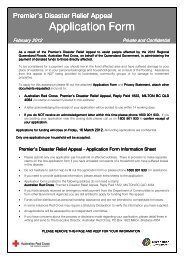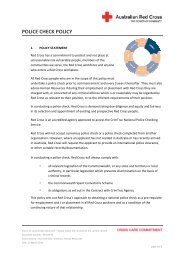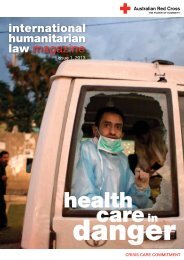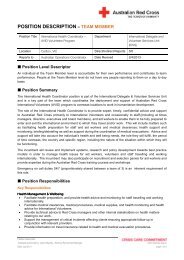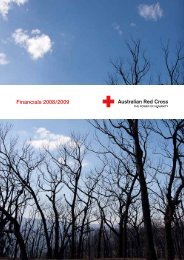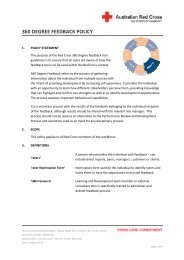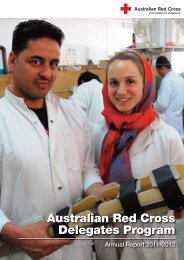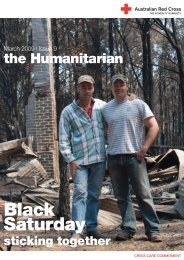Section 3: Draft Communication Strategy - Australian Red Cross
Section 3: Draft Communication Strategy - Australian Red Cross
Section 3: Draft Communication Strategy - Australian Red Cross
- No tags were found...
You also want an ePaper? Increase the reach of your titles
YUMPU automatically turns print PDFs into web optimized ePapers that Google loves.
Sample generic messagesThe following tables provide sample generic messages for a range of stakeholders. Keystakeholders were identified as:• people affected by an emergency• the public, including:··potential spontaneous volunteers··spontaneous volunteers• media• government• agencies involved with both response and recovery• peak bodies.These messages can be tailored to meet the needs of the jurisdiction, municipality oragency. The messages assume that there is a pre-agreed way in which spontaneousvolunteers can register, if required. They also assume that offers of help meet, or exceed,demand.Pre-emergency messagesThese might include:• a public awareness–raising campaign delivered through the media, social networkingsites and jurisdiction, municipal and agency websites• internal communication within organisations involved in the response to and recoveryfrom an emergency.Target audience Suggested message content RationaleThe publicWe know that people’s hearts open at times ofdisaster and they want to help by volunteering.If you want to be able to help next time there’san emergency, you need to attend training• Assuring the publicthat plans are inplace to respond toemergencies.now—don’t wait for an emergency to volunteer. • Strengthening agenciesThere are plans in place to respond to any type through new volunteerof emergency, anywhere in the country. Trained recruitment.personnel, including volunteers, implement theseplans by responding to the emergency and aidingthe recovery of affected communities. If you areinterested in being involved …Staff and volunteersworking withinexisting emergencymanagement plansA plan has been developed for the management ofpeople who want to volunteer in emergencies. Thiscan be found at … As part of the plan, messagesfor each stage of an emergency have been drafted.These will be circulated to all staff and volunteers inan emergency to ensure that everyone is clear onthe jurisdiction’s/municipality’s/organisation’s [deleteas applicable] response to offers of help.• Promoting clearand consistentcommunication.4Managing spontaneous volunteers in emergencies: <strong>Draft</strong> <strong>Communication</strong> <strong>Strategy</strong>
Ministerial messagesStages Suggested message content Rationale1. Emerging • Trained emergency services personnel are respondingto the event.• The needs of the affected communities have yet to beidentified.• The public can best assist by staying away from theaffected area and not calling agencies to offer theirhelp. There is no call for volunteers at this time.2. Initial response • We are working with affected communities to identifytheir needs. Please continue to stay away.• Specialist skills may be required. These will beadvertised on …• The best way the public can help is by donatingmoney or raising funds through an approved activityfor the emergency appeal. See the website … for howto do this.3. Ongoing response • Thank you for your offers of help and your patiencewhile the needs of the affected community/communities continue to be assessed.• Specialist skills are now required. These are advertisedon …• Please continue to support those affected by donatingmoney or raising funds through an approved activityfor the emergency appeal. See the website … for howto do this.4. Stand down • Thank you for your offer of help [this may be a mediaannouncement, letter or email from the relevantminister].• There is no longer an immediate need for volunteers.• [The coordinating agency] now has more offers ofhelp than can be used.• If you are interested in volunteering with an agency inthe future, please contact …A holding message designed to takethe heat out of the situation:• If no message is given, peoplewill go to the affected site or startcontacting agencies, particularlythose involved in the response.• There is no call to action.An updated holding message whichacknowledges that specific skills maybe needed, even if they have notcurrently been identified:• There is usually an emergencyappeal.• It is important to thank those whoare keen to help.• The message reassures the publicthat the needs of those affected bythe emergency are being met.• It is specific about what help isrequired and states that onlyindividuals who have specialistskills may be used.• It is important to thank those whoare keen to help or have helped.• The message reassures the publicthat the needs of those affected bythe emergency are being met.• The message seeks to strengthenagencies through new volunteerrecruitment.5Managing spontaneous volunteers in emergencies: <strong>Draft</strong> <strong>Communication</strong> <strong>Strategy</strong>
Messages from agencies accepting spontaneousvolunteersStages Suggested message Rationale1. Emerging2. Initial response3. Ongoing responseThank you very much for your offer of help. Toensure a coordinated response, all interestedvolunteers for this emergency need to registerat …4. Stand down Message to members of the public referred to theagency.Thank you for your help during this emergency.The help you have given has been muchappreciated. If you would be interestedin volunteering with [the agency] in futureemergencies ...• Promoting acoordinated approachto the registrationand management ofspontaneous volunteers.• Minimising agencyresources diverted tomanage offers of help.• It is important to thankthose who have helped.• The message seeks tostrengthen agenciesthrough new volunteerrecruitment.Messages from agencies not accepting spontaneousvolunteersStages Suggested message Rationale1. Emerging2. Initial response3. Ongoing responseThank you very much for your offer of help. Toensure a coordinated response, all interestedvolunteers for this emergency need to registerat …We are currently fortunate enough to not requireadditional help at this time. Should this change,we will source volunteers from [the coordinatingagency]. If you are interested in volunteering with[agency name] in the future, please go to ourwebsite …For persistent offers of help the following messagemight be appropriate.Due to the nature of the work our volunteersperform, there are certain training and legislativerequirements that must be met. As a result, weare unable to process new volunteers for thisemergency. If you are interested in volunteeringwith [agency name] in the future, please registeryour interest with [the coordinating agency].To ensure a coordinated response to offers ofhelp, all interested volunteers for this emergencyneed to register at ...• Promoting acoordinated approachto the registrationand management ofspontaneous volunteers.• Providing the rationale fordeclining offer of help.• Promoting ongoingvolunteering opportunitieseven if the agency isoverwhelmed by theemergency and is unableto process new volunteerapplications at the time.8Managing spontaneous volunteers in emergencies: <strong>Draft</strong> <strong>Communication</strong> <strong>Strategy</strong>
Social networking sitesSocial networking sites provide a powerful and immediate avenue for the delivery of any message.Delivering a message about spontaneous volunteering that is consistent with messages delivered in themedia and by agencies will reinforce the need for people to stay away from affected areas, while updatingcommunity members about any specialist skills needed.In the absence of a message, or if conflicting messages are given, people are more likely to feel there is aneed for their help. Feedback from the primary research reflected this scenario:‘I thought people were desperately needed to help sort out donations etc. It wasmentioned in the media, interviews etc. But I was not contacted.’‘The media made out volunteers were desperately needed.’ 4The immediacy of social networking sites means that messages need to be constantly updated, at leastdaily. The time required may appear a barrier, but it is an investment, and will assist in either seekingrelevant and specific assistance or keeping the public away from affected areas and channelling theirefforts into more appropriate ways of helping.4A. Cottrell, ‘A survey of spontaneous volunteers’, 2010.9Managing spontaneous volunteers in emergencies: <strong>Draft</strong> <strong>Communication</strong> <strong>Strategy</strong>





